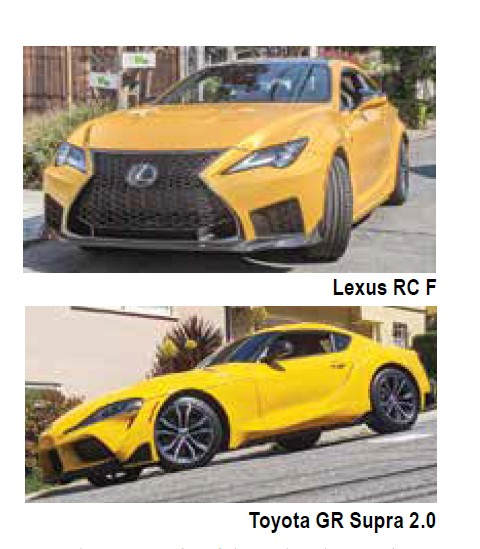
By Philip Ruth–
Yellow comes and goes, in terms of being fashionable for cars. Children of the 1970s will recall this cheerful color being available on just about every model, from Colts to Coupe de Villes. Our family Chevette was selected in something akin to Safety Yellow, which likely helped prevent that punishingly slow hatchback from being rear-ended on a regular basis.
Since then, car colors have become more muted, with black, white, and silver pushing niche shades to the margins. So, you won’t find many mid-level or upscale sedans and SUVs in yellow; you’d look instead to little cars like the Chevy Spark, or sporty models like the two we’re examining this time: the Lexus RC F and Toyota GR Supra 2.0.
They’re both Toyota products, and both yellows look similar but carry different names; Lexus calls the RC’s Flare Yellow, while the Supra’s goes by Nitro Yellow. Whatever the descriptors, their vibrant finishes attracted big attention in their times here, with both acting as rays of sunshine poking through the seas of surrounding grays.
You’ll have to pay for it if you want a vehicle with this kind of vivid distinction—Toyota charges $425 for its yellow, and Lexus is a bit higher at $595. These options brought the bottom lines to $48,040 for the GR Supra 2.0 and $90,705 for the RC F. There’s still room to grow with the Supra, as bigger engines and performance enhancements can boost the base price up over $60,000, while the RC F represents the top of the RC range.
The sharp styling underneath the lighthearted color is aggressive in both the Supra and the RC. The Supra shares much with the BMW Z4, and while the BMW is a modern interpretation of traditional brand cues like the twin-kidney grille, the Toyota is bold and daring with its pronounced curves and flares.

Meanwhile the tested RC F appeared to mean business with its $11,400 Carbon Package, which installs carbon fiber trim on the roof and in the added aerodynamic enhancements. I wouldn’t call either of them timeless or beautiful, but the point here is for them to pack a visual punch, and they do.
Both deliver authoritative performance. The Supra 2.0 I drove effectively transferred its 255 horsepower to the ground, with turbocharged acceleration and bracingly stable handling. The RC F’s V8 put it in another league as it belted out 472 horses through the $1,250 Torque Vectoring Differential, a neat innovation that puts power to the wheels via a multi-clutch system aided by electric motors. Its benefits are geared more for track days than street use.
Inside, the Supra is close-coupled, with a low seating position and a high console and instrument panel. The RC is larger and thus feels more like a touring car than a bare-knuckle racer, even if it is quite capable of adopting that role.
If you’re into yellow, here are two distinct and satisfying personalities with which to enjoy it.
Philip Ruth is a Castro-based automotive photojournalist and consultant with an automotive staging service.
Published on February 10, 2022
Recent Comments